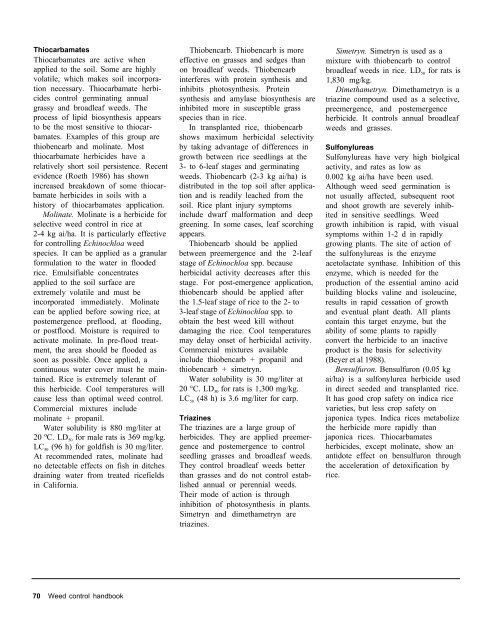A handbbok on Weed Control in Rice.pdf
A handbbok on Weed Control in Rice.pdf
A handbbok on Weed Control in Rice.pdf
You also want an ePaper? Increase the reach of your titles
YUMPU automatically turns print PDFs into web optimized ePapers that Google loves.
Thiocarbamates<br />
Thiocarbamates are active when<br />
applied to the soil. Some are highly<br />
volatile, which makes soil <strong>in</strong>corpora-<br />
ti<strong>on</strong> necessary. Thiocarbamate herbi-<br />
cides c<strong>on</strong>trol germ<strong>in</strong>at<strong>in</strong>g annual<br />
grassy and broadleaf weeds. The<br />
process of lipid biosynthesis appears<br />
to be the most sensitive to thiocar-<br />
bamates. Examples of this group are<br />
thiobencarb and mol<strong>in</strong>ate. Most<br />
thiocarbamate herbicides have a<br />
relatively short soil persistence. Recent<br />
evidence (Roeth 1986) has shown<br />
<strong>in</strong>creased breakdown of some thiocar-<br />
bamate herbicides <strong>in</strong> soils with a<br />
history of thiocarbamates applicati<strong>on</strong>.<br />
Mol<strong>in</strong>ate. Mol<strong>in</strong>ate is a herbicide for<br />
selective weed c<strong>on</strong>trol <strong>in</strong> rice at<br />
2-4 kg ai/ha. It is particularly effective<br />
for c<strong>on</strong>troll<strong>in</strong>g Ech<strong>in</strong>ochloa weed<br />
species. It can be applied as a granular<br />
formulati<strong>on</strong> to the water <strong>in</strong> flooded<br />
rice. Emulsifiable c<strong>on</strong>centrates<br />
applied to the soil surface are<br />
extremely volatile and must be<br />
<strong>in</strong>corporated immediately. Mol<strong>in</strong>ate<br />
can be applied before sow<strong>in</strong>g rice, at<br />
postemergence preflood, at flood<strong>in</strong>g,<br />
or postflood. Moisture is required to<br />
activate mol<strong>in</strong>ate. In pre-flood treat-<br />
ment, the area should be flooded as<br />
so<strong>on</strong> as possible. Once applied, a<br />
c<strong>on</strong>t<strong>in</strong>uous water cover must be ma<strong>in</strong>-<br />
ta<strong>in</strong>ed. <strong>Rice</strong> is extremely tolerant of<br />
this herbicide. Cool temperatures will<br />
cause less than optimal weed c<strong>on</strong>trol.<br />
Commercial mixtures <strong>in</strong>clude<br />
mol<strong>in</strong>ate + propanil.<br />
Water solubility is 880 mg/liter at<br />
20 ºC. LD 50 for male rats is 369 mg/kg.<br />
LC 50 (96 h) for goldfish is 30 mg/liter.<br />
At recommended rates, mol<strong>in</strong>ate had<br />
no detectable effects <strong>on</strong> fish <strong>in</strong> ditches<br />
dra<strong>in</strong><strong>in</strong>g water from treated ricefields<br />
<strong>in</strong> California.<br />
70 <strong>Weed</strong> c<strong>on</strong>trol handbook<br />
Thiobencarb. Thiobencarb is more<br />
effective <strong>on</strong> grasses and sedges than<br />
<strong>on</strong> broadleaf weeds. Thiobencarb<br />
<strong>in</strong>terferes with prote<strong>in</strong> synthesis and<br />
<strong>in</strong>hibits photosynthesis. Prote<strong>in</strong><br />
synthesis and amylase biosynthesis are<br />
<strong>in</strong>hibited more <strong>in</strong> susceptible grass<br />
species than <strong>in</strong> rice.<br />
In transplanted rice, thiobencarb<br />
shows maximum herbicidal selectivity<br />
by tak<strong>in</strong>g advantage of differences <strong>in</strong><br />
growth between rice seedl<strong>in</strong>gs at the<br />
3- to 6-leaf stages and germ<strong>in</strong>at<strong>in</strong>g<br />
weeds. Thiobencarb (2-3 kg ai/ha) is<br />
distributed <strong>in</strong> the top soil after applica-<br />
ti<strong>on</strong> and is readily leached from the<br />
soil. <strong>Rice</strong> plant <strong>in</strong>jury symptoms<br />
<strong>in</strong>clude dwarf malformati<strong>on</strong> and deep<br />
green<strong>in</strong>g. In some cases, leaf scorch<strong>in</strong>g<br />
appears.<br />
Thiobencarb should be applied<br />
between preemergence and the 2-leaf<br />
stage of Ech<strong>in</strong>ochloa spp. because<br />
herbicidal activity decreases after this<br />
stage. For post-emergence applicati<strong>on</strong>,<br />
thiobencarb should be applied after<br />
the 1.5-leaf stage of rice to the 2- to<br />
3-leaf stage of Ech<strong>in</strong>ochloa spp. to<br />
obta<strong>in</strong> the best weed kill without<br />
damag<strong>in</strong>g the rice. Cool temperatures<br />
may delay <strong>on</strong>set of herbicidal activity.<br />
Commercial mixtures available<br />
<strong>in</strong>clude thiobencarb + propanil and<br />
thiobencarb + simetryn.<br />
Water solubility is 30 mg/liter at<br />
20 °C. LD 50 for rats is 1,300 mg/kg.<br />
LC 50 (48 h) is 3.6 mg/liter for carp.<br />
Triaz<strong>in</strong>es<br />
The triaz<strong>in</strong>es are a large group of<br />
herbicides. They are applied preemer-<br />
gence and postemergence to c<strong>on</strong>trol<br />
seedl<strong>in</strong>g grasses and broadleaf weeds.<br />
They c<strong>on</strong>trol broadleaf weeds better<br />
than grasses and do not c<strong>on</strong>trol estab-<br />
lished annual or perennial weeds.<br />
Their mode of acti<strong>on</strong> is through<br />
<strong>in</strong>hibiti<strong>on</strong> of photosynthesis <strong>in</strong> plants.<br />
Simetryn and dimethametryn are<br />
triaz<strong>in</strong>es.<br />
Simetryn. Simetryn is used as a<br />
mixture with thiobencarb to c<strong>on</strong>trol<br />
broadleaf weeds <strong>in</strong> rice. LD 50 for rats is<br />
1,830 mg/kg.<br />
Dimethametryn. Dimethametryn is a<br />
triaz<strong>in</strong>e compound used as a selective,<br />
preemergence, and postemergence<br />
herbicide. It c<strong>on</strong>trols annual broadleaf<br />
weeds and grasses.<br />
Sulf<strong>on</strong>ylureas<br />
Sulf<strong>on</strong>ylureas have very high biolgical<br />
activity, and rates as low as<br />
0.002 kg ai/ha have been used.<br />
Although weed seed germ<strong>in</strong>ati<strong>on</strong> is<br />
not usually affected, subsequent root<br />
and shoot growth are severely <strong>in</strong>hib-<br />
ited <strong>in</strong> sensitive seedl<strong>in</strong>gs. <strong>Weed</strong><br />
growth <strong>in</strong>hibiti<strong>on</strong> is rapid, with visual<br />
symptoms with<strong>in</strong> 1-2 d <strong>in</strong> rapidly<br />
grow<strong>in</strong>g plants. The site of acti<strong>on</strong> of<br />
the sulf<strong>on</strong>ylureas is the enzyme<br />
acetolactate synthase. Inhibiti<strong>on</strong> of this<br />
enzyme, which is needed for the<br />
producti<strong>on</strong> of the essential am<strong>in</strong>o acid<br />
build<strong>in</strong>g blocks val<strong>in</strong>e and isoleuc<strong>in</strong>e,<br />
results <strong>in</strong> rapid cessati<strong>on</strong> of growth<br />
and eventual plant death. All plants<br />
c<strong>on</strong>ta<strong>in</strong> this target enzyme, but the<br />
ability of some plants to rapidly<br />
c<strong>on</strong>vert the herbicide to an <strong>in</strong>active<br />
product is the basis for selectivity<br />
(Beyer et al 1988).<br />
Bensulfur<strong>on</strong>. Bensulfur<strong>on</strong> (0.05 kg<br />
ai/ha) is a sulf<strong>on</strong>ylurea herbicide used<br />
<strong>in</strong> direct seeded and transplanted rice.<br />
It has good crop safety <strong>on</strong> <strong>in</strong>dica rice<br />
varieties, but less crop safety <strong>on</strong><br />
jap<strong>on</strong>ica types. Indica rices metabolize<br />
the herbicide more rapidly than<br />
jap<strong>on</strong>ica rices. Thiocarbamates<br />
herbicides, except mol<strong>in</strong>ate, show an<br />
antidote effect <strong>on</strong> bensulfur<strong>on</strong> through<br />
the accelerati<strong>on</strong> of detoxificati<strong>on</strong> by<br />
rice.











